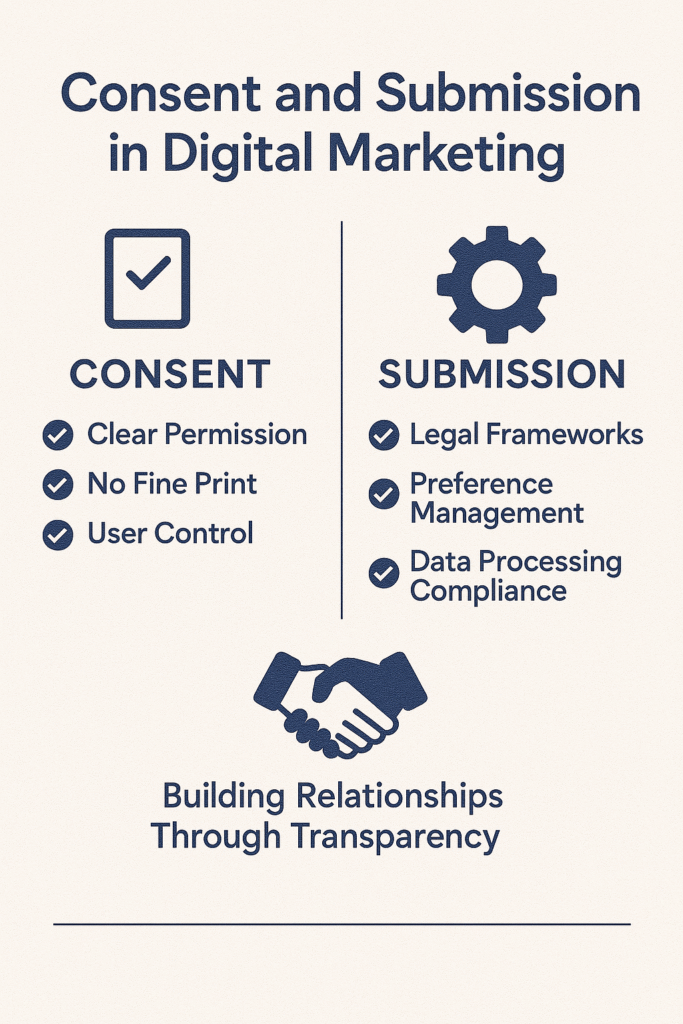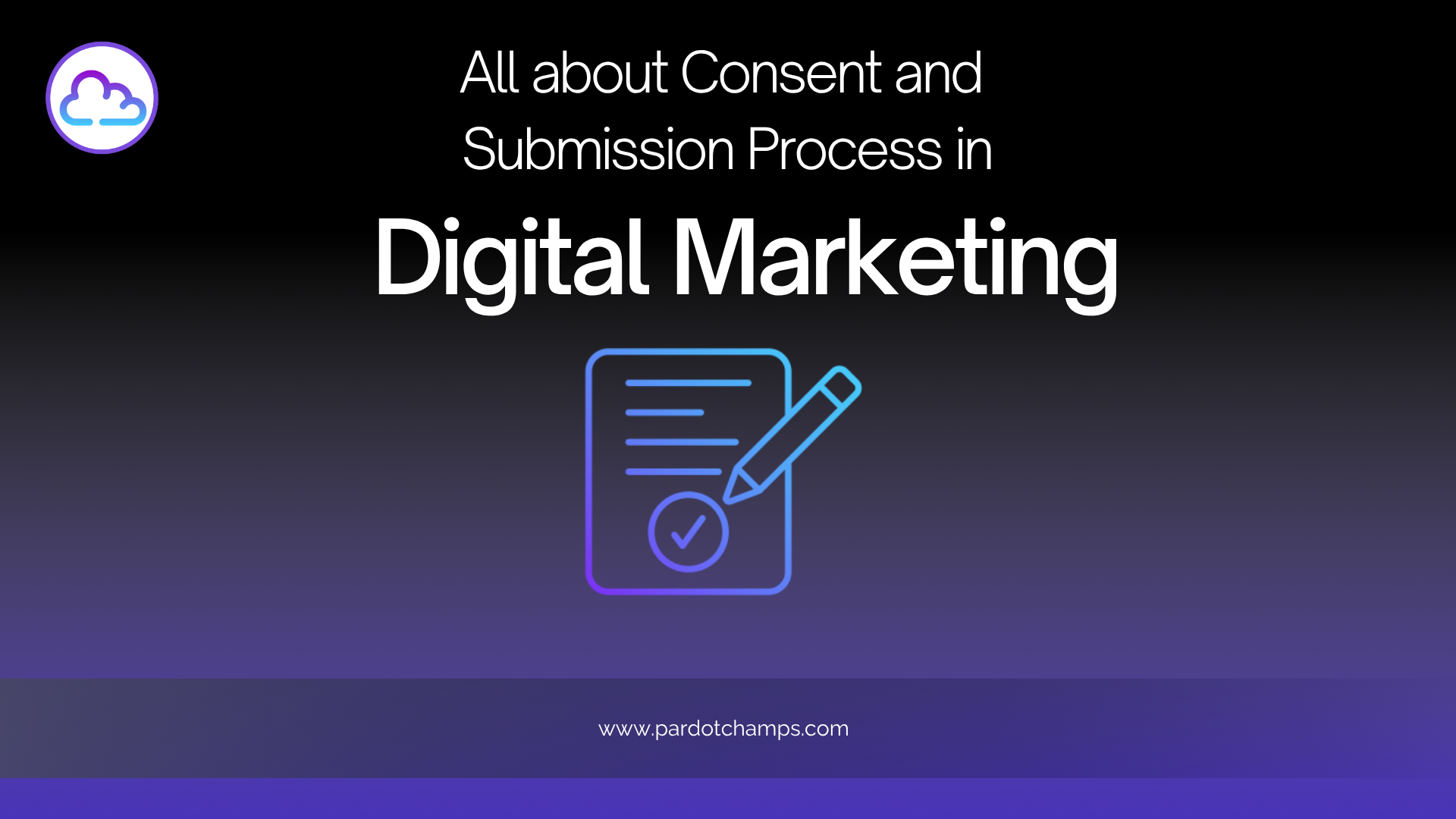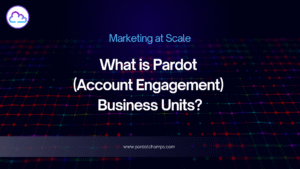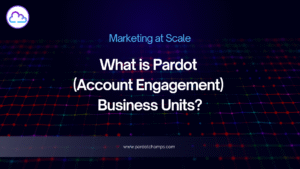Explore the essentials of consent and submission in digital marketing. Learn how to stay compliant with GDPR, CCPA, and global privacy laws while building trust and driving results through ethical data practices.
Consent and submission in Digital Marketing aren’t just legal requirements—they’re foundational to a respectful and sustainable marketing strategy. By prioritizing user permission and clear opt-in mechanisms, brands can create more meaningful connections with their audiences and reduce the risk of non-compliance penalties.
- Consent and Submission in Digital Marketing
- Why Consent and Submission In Digital Marketing Matter More Than Ever
- What Do We Mean by Consent and Submission?
- Key Areas to Master: A Roadmap to Privacy Success
- The Final Word: Privacy Is the Future of Marketing
- Privacy-First Marketing Checklist
- Let’s Build Trust-Driven Marketing Together
- Frequently asked Questions
Consent and Submission in Digital Marketing
Digital marketing has transformed. The era of unchecked data collection is over—replaced by a global demand for accountability, security, and trust. Today’s consumers expect privacy by default. Regulators are enforcing it. And marketers must now balance performance with compliance.
The solution lies in getting consent and submission in Digital Marketing. These are no longer optional legal checkboxes—they’re strategic imperatives. Whether you use Salesforce, Pardot, HubSpot, or any other platform, embedding privacy into every touchpoint is essential for sustainable, high-performing marketing.
Here at Pardot champs, we did learn an important thing during our years of leading marketing teams and consulting brands, a shares view to fellow marketers across different organization a regions, the fact is uncomplicated & simple “Management doesn’t care about how you handles your digital marketing; it’s all about the result ”

So, we pledge to help marketers follow data privacy law & best implementation.
Why Consent and Submission In Digital Marketing Matter More Than Ever
Trust has become the most valuable—and fragile—currency in digital marketing.
The rules of engagement have been rewritten. The General Data Protection Regulation (GDPR) in Europe, the California Consumer Privacy Act (CCPA), Canada’s Anti-Spam Law (CASL), and new frameworks from Brazil (LGPD) to India (DPDP) have codified what should have been intuitive all along: individuals own their data, and brands must earn the right to use it.
Gone are the days when capturing a lead and launching a nurture sequence was a matter of a single checkbox—if any at all. Failing to secure explicit, informed, and traceable consent doesn’t just open the door to regulatory fines. It corrodes customer trust, invites reputational damage, and undermines the credibility of your entire marketing operation.
In an age of growing online caution, consent and submission in digital marketing—paired with genuine respect for privacy—are the keys to earning trust and driving meaningful, lasting success.
What Do We Mean by Consent and Submission?
Consent is the clear, affirmative permission granted by a user for their personal data to be collected, stored, and used. It is not implied. It is not coerced. And it is never hidden in fine print.
Submission, on the other hand, refers to the behind-the-scenes machinery: the legal, technical, and procedural systems that ensure consent is honored, preferences are recorded, and data is processed in accordance with policy and regulation.
Together, they form a two-part contract between brand and user—one based on clarity, control, and respect. This is not about ticking compliance boxes. It’s about creating sustainable relationships in a world where customers have never had more power—or more reasons to walk away.
Consent and submission in digital marketing work hand-in-hand to create transparent, respectful relationships that go beyond compliance and build lasting customer trust.
Key Areas to Master: A Roadmap to Privacy Success
The journey toward privacy-centric marketing can be distilled into four core phases: Consent Registration, Submission Flow, Privacy (Seclusion) Plan, and Execution. Each is a pillar. Miss one, and the entire structure falters.
1. Consent Registration: Start With Knowing Your Audience
Effective consent begins with knowledge. You cannot collect compliant consent if you don’t understand who your audience is, where they’re located, and what legal protections apply to them.
Geography is everything. A prospect in Berlin falls under GDPR. One in San Francisco? CCPA. Targeting Canadian professionals? You’re in CASL territory. India’s Digital Personal Data Protection Act (DPDP) is already reshaping APAC data norms, and Australia’s Privacy Act is tightening its scope. The regulatory patchwork is vast, but ignorance is no defense.
Beyond geography, consider demographic nuances. Are you marketing to minors, retirees, or healthcare professionals? Each audience may invoke additional layers of compliance and sensitivity.
Start with an audit:
- Do you apply online configuration websites for asset downloads, contact requests or event enrollments?
- What necessary information do you ask for this configuration?
- What are those conveying mediums?
- Do you ask for your viewers (listeners) to go into communications?
- Once you’ve appended the data, what system do you merge with?
- Where do the details live and who retrieves the details of data?
Use your CRM and marketing automation tools to segment your audience by jurisdiction and compliance level. Dynamic content and smart forms can tailor experiences to reflect regional privacy standards in real time.
This is how you shift from generic compliance to strategic personalization.
2. Submission Flow: Spot the Gaps Before They Cost You
Capturing consent is just the beginning. What happens next determines whether you’re operating within the law—or on borrowed time.
The submission flow is the data journey. It encompasses how consent is stored, synchronized, accessed, and respected across your systems.
Let’s say a prospect registers for a whitepaper and checks a box to receive promotional emails. That consent must be:
- Stored with metadata (timestamp, IP, method)
- Linked to the individual’s profile in your CRM
- Synced with every marketing system that touches that profile
Disjointed systems are dangerous. If one platform has them opted out and another still sends emails, you’re in violation—possibly on multiple fronts.
Scrutinize every touchpoint:
- Is the relevant opt-ins available and motive for collection distinctly expressed?
- Are you asking for communicated consent that is unbundled?
- Are the consent alternatives explicit?
Use GDPR as your north star. Even if your primary audience isn’t European, building to the highest standard offers universal protection and future-proofing.
If your current tech stack can’t support detailed, audit-ready submission flows, it’s time for modernization.
3. Seclusion Plan: Build Trust Into the Journey
Privacy isn’t a legal document. It’s a mindset. A culture. A brand promise.
Your Privacy Plan—or Seclusion Strategy—is your internal compass. It governs how data is collected, processed, stored, shared, and ultimately deleted. It should be written, enforced, and understood at every level of the organization.
A robust plan includes:
- Data retention timelines (what you keep, and for how long)
- Role-based access (who sees what, and why)
- Platform policies (which tools are approved, and under what conditions)
- User rights (how individuals can request deletion, correction, or access)
Marketing must be fluent in this language. Every campaign, form, and landing page must reflect these principles—subtly, but visibly.
This isn’t just about mitigating legal risk. A mature privacy posture communicates care. It tells customers that their data isn’t a commodity—it’s a responsibility.
Small design choices reinforce this: unobtrusive privacy notices, plain-language explanations of data usage, links to preference centers. These are trust cues. They compound over time.
4. Putting Your Submission Plan into Action
Compliance on paper means nothing without putting it into practice with strict discipline.
Technology is your ally—but only if configured properly. Let’s examine two of the industry’s most privacy-capable platforms: Salesforce and Pardot.
Salesforce Consent Management
This module lets you:
- Track multi-channel consent (email, SMS, phone, etc.)
- Record consent changes with time stamps and methods
- Segment audiences based on granular preference fields
Pardot Preferences Center
A self-service portal for subscribers to manage how they hear from you. Use custom fields for GDPR compliance and clear labeling for transparency.
Best Practices:
- Use custom objects for region-specific regulations (e.g., LGPD or DPDP).
- Sync with tools like OneTrust or TrustArc via API to centralize consent data.
- Set up real-time automation to suppress leads who withdraw consent.
- Create alerts for manual overrides or conflicting entries.
Data silos are your enemy. A single source of truth is your goal. If consent changes in one system, it must cascade across all others.
Audit this regularly. Because nothing will erode trust faster than emailing a user who opted out weeks ago.
5. When Should You Start?
Putting off privacy work is risky. Privacy isn’t just a task—it’s a way of doing business. You cannot afford to delay implementation until you’re staring down a lawsuit or a news cycle.
Start with an audit:
- Identify every form in the wild.
- Document where and how data is stored.
- Validate every opt-in mechanism.
Then partner with legal. Map which regulations apply to your regions, verticals, and customer segments. Rebuild forms and flows to align.
Train your marketing team. Every employee should understand the privacy policy—not just the CMO and the legal department.
What Happens If You Wait?
- Regulatory fines (GDPR alone permits penalties up to €20 million)
- Loss of customer confidence (and lifetime value)
- Poor deliverability due to spam complaints
- Dirty data and inaccurate reporting
The ROI of privacy-first marketing is real: higher email engagement, better list hygiene, and more qualified leads. You don’t lose speed—you gain sustainability.
The Final Word: Privacy Is the Future of Marketing
Let’s be clear and direct : if you ignore consent and submission in digital marketing, you are not just out of compliance—you’re out of alignment with your audience.
Privacy-first marketing isn’t just ethical. It’s strategic. It’s how modern brands scale trust at the same velocity as technology.
Those who lead with clarity, transparency, and respect will win. Those who lag will be punished—by law, by inboxes, and by the invisible hand of consumer choice.
It’s time to elevate privacy from legal obligation to strategic advantage. Make it a differentiator. Make it your standard.
Privacy-First Marketing Checklist
- Identify target geographies and applicable laws
- Audit current forms and data capture methods
- Implement or upgrade submission flows
- Build or update your organizational privacy policy
- Train all marketing staff on best practices
- Utilize tools like Salesforce, Pardot, and OneTrust
- Automate consent syncing across all platforms
- Prioritize transparency in all customer touchpoints
Let’s Build Trust-Driven Marketing Together
Have ideas, experiences, or insights to share? Join the conversation below. This is a new era—and we’re all navigating it together.
Trust isn’t just a buzzword—it’s a strategy. In a world where consent and submission in digital marketing shape the future, it’s time to lead with transparency, respect, and integrity.
Happy Marketing.
Frequently asked Questions
1. What’s the difference between consent and submission?
Consent is user permission to use their data; submission is the act of providing it. Both are needed for compliance.
2. Why is consent important?
It’s required by laws like GDPR and CCPA to protect user privacy and avoid fines.
3. Can consent hurt conversions?
Not if done right. Clear opt-ins and value-driven messaging can boost trust and engagement.






